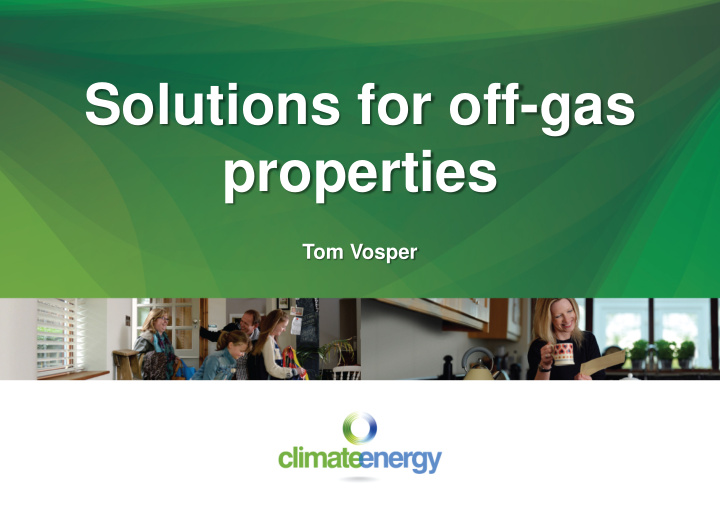



Solutions for off-gas properties Tom Vosper
About Climate Energy Climate Energy is one of the UK’s largest independent energy efficiency companies. The Climate Energy Group includes: Climate Energy Ltd – accredited Green Deal and ECO Provider Climate Energy Homes – Low carbon new build system Climate Energy Solutions – MCS accredited insulation, heating & renewables installer Climate Energy Business Solutions – Providing independent low carbon and sustainable energy services and project funding solutions
Local Council Partnerships
Main heating fuels in Britain Source: Consumer Focus’ 2011 “Off-gas consumers” report
Main heating fuels in Britain (2)
Challenges for off-gas homes No direct access to the cheapest heating option Often exposed locations - higher convective losses and no “heat island” Normally high cost of connection to gas (if it’s possible) Off-gas properties are far more likely to suffer from fuel poverty Standard off-gas heating systems Heating type Pros (compared with gas) Cons (compared with gas) Oil & LPG boilers - Expensive fuel Electric storage Zero maintenance cost Generally poor control heaters Night rate can cut non- Expensive heating costs if used wisely Uplift on day rate tariff Peak electric Zero maintenance Most expensive heaters
Possible solutions Insulation, insulation, insulation! Improve air tightness but consider ventilation requirement Behaviour change Heat pump - GS / AS District/communal heating (biomass) Solar thermal Solar PV (perhaps with EMD) Individual biomass boiler Voltage Optimisation
Spire Homes – Derwent Drive Six 3-storey blocks of flats (54 units in total) All heated by electric storage heaters Reasonable energy efficiency already (LI, CWI, DG) Off the gas network but only just (half km to gas pipe with sufficient capacity)
Spire Homes – Derwent Drive Surveyed the site & spoke at length to TLO to gather local knowledge Discussed with client and ended with a cut-down list of option: 1. Extend gas network and install gas combination boilers 2. Installation of peak electric radiators 3. Replacement of storage heaters with newer models 4. Individual GSHP with communal ground loop – non-domestic RHI 5. Individual GSHP with separate ground loops – domestic RHI Appraised each option from a technical, financial, environmental, legislative & logistical perspective Appraised each option from a Spire Homes and a tenant perspective
Financial comparisons: Spire Homes Economic Perspective 0 Years 0 5 10 15 20 25 -2,000 -4,000 Spire Homes Cashflow (£) -6,000 Option 1 - Gas Boiler Option 2 - Elec. Peak -8,000 Option 3 - Elec. Storage Option 4 - Comm GSHP Option 5 - Indiv GSHP -10,000 -12,000 -14,000 -16,000
Financial comparisons: Tenant Perspective - Years 0 5 10 15 20 25 (10,000) Tenant cashflow (from bills) (£) (20,000) Option 1 - Gas Boiler Option 2 - Elec. Peak (30,000) Option 3 - Elec. Storage Option 4/5 - GSHP (40,000) (50,000) (60,000) 1,200 1,085 1,000 831 Annual tenant bill (£) 800 598 600 400 305 305 200 - Option 1 - Gas Option 2 - Elec. Option 3 - Elec. Option 4 - Comm Option 5 - Indiv Boiler Peak Storage GSHP GSHP
Financial comparisons: Overall project 0 Years 0 5 10 15 20 25 -10,000 Overall Project Cashflow (£) -20,000 Option 1 - Gas Boiler Option 2 - Elec. Peak -30,000 Option 3 - Elec. Storage Option 4 - Comm GSHP Option 5 - Indiv GSHP -40,000 -50,000 -60,000
TCHG ASHP installations Completed around 30 individual ASHP installations on a rural housing estate Lessons: Pre-project consideration of tenant energy use (insulation, emitters, tariffs, behaviour...) Early resident engagement to explain the “new” system and set expectations Careful noise assessment is critical and liaison with residents and installer for external unit siting Planning approval High quality training and handover to tenant
TCHG Solar PV Results: 132 Houses + 4 blocks with 93 flats - Total 391kWp Total cost ~£1.2m Projected annual income from FiT including export tariff ~£120k Resident bill savings £20 - £180 pa per dwelling Lifetime CO2 savings in excess of 4300 tonnes
Domestic VO trials Aims: Alleviate uncertainty around domestic VO Lack of independent study on savings Compare the units available on the market Results: Understanding product differences and property fit Calculated savings of between 3% and 8% per year on resident bills equivalent to between £10 and £60, average of about £30. Tenant perceived savings of £100 - £200 including behaviour change
Final comments Fits well with Comments Insulation & draft proofing Everything! Heat pump - GS / AS ST & PV Check heat emitters, existing tariffs & behaviour. Explain differences. District/communal heating ST Tenant views. Actual heat loads. Tariff setting. (biomass led) Metering & billing issues. Individual biomass boiler ST Space. EPC heat loads. Solar thermal HPs Solar PV (with EMD?) HPs Voltage Optimisation - Every property is different and tenants can be even more different! So don’t take a one size fits all approach - come and talk to us instead to see how we can help.
Thank you Tom Vosper tom.vosper@climate-consulting.co.uk 020 8633 9801
Recommend
More recommend